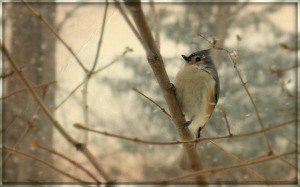 By Darla Antoine, ICTMN
By Darla Antoine, ICTMN
From crows and robins to woodpeckers and cardinals. Not every bird flies south for the winter. Depending on where you are, you could be enjoying the company of a number of species that choose to tough out the winters. Why not make it a little easier on them by providing a few bird feeders in your backyard? Not only will it be easier for the birds to find food in freezing temperatures, but their colorful little wings will also brighten up your backyard.
During the colder months food can be scarce for birds. Berries are gone, insects are dead or dormant, and other food sources may be hard to come by. As can protection from freezing winds and the dark cold of winter nights.
To stay warm birds try to conserve their energy by flying as little as possible. They also puff up their feathers to create air pockets of insulation that help keep them warm. To keep their metabolism at a normal rate they need to compensate for the expended energy needed to keep warm by eating rich, nutrient-dense foods. Basically they need to get as many calories in as they can with as little effort as possible. Though birdseed may be enough in the summer it’s a good idea to offer your feathered friends suet in the winter.
Suet comes in little hard cakes and contains animal fat, seeds, nuts, grains and dried fruits. Though you can buy it just about anywhere, it is surprisingly simple and economical to make, especially if your family is doing any hunting this fall and you have access to some animal fat, otherwise bacon grease or beef trimmings from the butcher will work. Word on the street is that the birds prefer the homemade version themselves too.
Homemade Suet
2 cups quick-cooking oats
2 cups cornmeal
1 cup flour
½ cup sugar
1 cup lard
1 cup crunchy peanut butter
In a medium saucepan, melt the lard and peanut butter over medium high heat, stirring occasionally.
In a separate bowl combine the oats, cornmeal, flour and sugar.
Add the dry ingredients to the melted fats.
Store the suet in a reusable container and scoop it out as needed. It’s recommended that you break up the suet into small chunks so that the squirrels can’t take too much at once.
Use a store-bought suet feeder to feed the birds or spread the suet directly on tree limbs.
And don’t forget to also offer the birds a little bit of warm water to drink and a few birdhouses or evergreen bushes to find sanctuary from the cold winds. With just a little bit of effort you can make the winter a lot more bearable for our feathered friends.

Darla Antoine is an enrolled member of the Okanagan Indian Band in British Columbia and grew up in Eastern Washington State. For three years, she worked as a newspaper reporter in the Midwest, reporting on issues relevant to the Native and Hispanic communities, and most recently served as a producer for Native America Calling. In 2011, she moved to Costa Rica, where she currently lives with her husband and their infant son. She lives on an organic and sustainable farm in the “cloud forest”—the highlands of Costa Rica, 9,000 feet above sea level. Due to the high elevation, the conditions for farming and gardening are similar to that of the Pacific Northwest—cold and rainy for most of the year with a short growing season. Antoine has an herb garden, green house, a bee hive, cows, a goat, and two trout ponds stocked with hundreds of rainbow trout.
Read more at http://indiancountrytodaymedianetwork.com/2013/11/17/our-feathered-friends-homemade-suet-and-backyard-winterizing-152296
